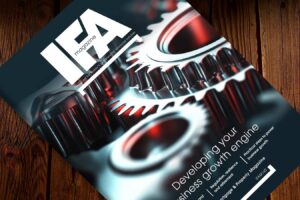In this exclusive interview with GBI Magazine, Fuel Ventures’ Head of IFA Distribution James D’Mello provides us with some expert advice ahead of the tax year end.
James outlines how investors can minimise tax liability and how individuals can make the most of their tax allowances. He also explains how CGT changes have impacted tax-efficient investments, how long-term tax planning can help investors reduce their overall tax burden, and provides some major tax considerations for those contemplating retirement.
James concludes by revealing the ways that investors can balance risk and return with their tax-efficient investment approaches, and whether there are any expected tax changes in the next financial year.
Q: What are the most effective strategies investors can use to minimise their tax liability before the end of the tax year?
With the tax year-end fast approaching, investors should be reviewing their portfolios to ensure they’re making the most of tax-efficient allowances and reliefs. One of the most effective ways to minimise tax liability is through venture capital schemes like SEIS, EIS, and VCTs, which offer generous tax incentives, including income tax relief, CGT deferral or exemption, and IHT mitigation. SEIS, in particular, remains one of the most compelling options for clients with the required level of risk appetite, with 50% income tax relief, CGT reinvestment relief, and the potential for tax-free growth. Those with realised gains could also consider reinvesting those gains into SEIS/EIS to defer or eliminate CGT liabilities.
Before venture capital, making full use of pension contributions and ISAs is essential. Carry-forward rules on pensions can allow investors to maximise contributions if they haven’t fully utilised their annual allowance in previous years. ISAs, while offering no upfront relief, allow tax-free growth and withdrawals, making them a core part of any tax-efficient investment strategy.
Q: How can individuals ensure they are making full use of available tax allowances?
A key step is to proactively review all available allowances before they reset at year-end. For high-net-worth investors, the capital gains tax (CGT) allowance has been significantly reduced, meaning efficient use of tax wrappers like ISAs, pensions, and venture capital schemes is even more important. SEIS and EIS investments allow deferral or exemption of capital gains, which is particularly relevant for investors facing increased CGT liabilities, whether that be from a business sale, share gains in a GIA or the sale of buy to let properties.
Another often overlooked area is dividend allowances—while these have been reduced in recent years, structuring income through tax-efficient vehicles such as VCTs (which provide tax-free dividends) can help. Speaking with a financial adviser before year-end can help investors optimise allocations and ensure no available tax reliefs are left unused.
Q: Which tax-saving opportunities should investors consider before the tax year closes?
For investors with capital gains, using SEIS and EIS to reinvest and defer or eliminate CGT remains a standout strategy. SEIS offers a unique CGT reinvestment relief, effectively reducing CGT liabilities on gains that are reinvested into qualifying companies.
Pension contributions should also be maximised, especially for those at risk of losing their personal allowance due to earnings over £100k—contributing into a pension can help bring taxable income below the threshold. Additionally, those with business interests could explore opportunities like pension contributions through a limited company.
For investors in VCTs, the ability to generate tax-free dividends can be particularly attractive in an environment where other tax-free income sources are diminishing. With the additional tax burden on dividends and increased rates of capital gains, tax-efficient investments are becoming more relevant than ever.
Q: In what way(s) has the change to the CGT impacted tax efficient investments?
The reduction in the CGT allowance from £12,300 to just £3,000 from April 2024 has made tax-efficient investments like SEIS and EIS even more valuable. Investors who previously relied on their annual CGT allowance to manage gains now need alternative strategies to offset tax liabilities.
SEIS is particularly compelling, offering a 50% CGT exemption on reinvested gains, meaning investors can significantly reduce their CGT bill while backing high-growth startups. EIS allows for CGT deferral, so investors can reinvest gains into qualifying companies and defer the tax liability indefinitely—potentially eliminating it altogether if held until death (Provided our Government doesn’t change that too!)
As the government continues to target CGT as a source of revenue, investors should be looking beyond traditional allowances like gifting and using structured tax-efficient investments to maintain their returns.
Q: How can long-term tax planning help investors reduce their overall tax burden?
Tax planning isn’t just about maximising reliefs in a single year—it’s about structuring investments over time to ensure sustained efficiency. Investors who regularly allocate to SEIS, EIS, and VCTs can build portfolios that reduce their ongoing tax exposure while generating strong long-term returns.
For example, an investor consistently using EIS can continue rolling forward CGT deferrals, effectively pushing back liabilities while benefiting from income tax relief on new investments. VCTs provide tax-free dividends, making them ideal for those looking to supplement their income in a tax-efficient way.
Additionally, estate planning should be a core consideration—EIS and AIM-listed shares that qualify for Business Relief can become IHT-free after two years, offering a compelling alternative to traditional inheritance tax planning tools like trusts. The key is to take a strategic, long-term approach rather than simply reacting at tax year-end.
Q: What are some important tax considerations for individuals planning for retirement?
For individuals planning for retirement, tax efficiency is key to maximising long-term income and wealth preservation. One of the most important considerations is ensuring full use of pension allowances. Making the most of annual pension contribution limits—and using carry-forward allowances where possible—can significantly reduce taxable income while growing retirement savings in a tax-advantaged environment.
Beyond pensions, investors should also consider how to generate tax-efficient income in retirement. ISAs provide a flexible, tax-free income stream, while VCTs offer tax-free dividends that can supplement retirement income. Those with capital gains should structure withdrawals carefully, making use of allowances and reinvesting in EIS to defer liabilities where appropriate.
Inheritance tax (IHT) planning should also be factored in early. Business Relief-qualifying investments, such as EIS and AIM-listed shares, can become IHT-free after two years, making them a useful tool for those looking to pass on wealth tax-efficiently. Ultimately, retirement planning should balance growth, income, and IHT efficiency to ensure long-term financial security.
Q: How can investors balance risk and return while maintaining an investment approach which is tax-efficient?
Risk management in tax-efficient investing is about diversification and understanding time horizons. SEIS and EIS investments come with higher risk but also higher potential returns, and spreading investments across multiple early-stage companies increases the probability of strong outcomes. Many investors mitigate risk by combining EIS with VCTs, which typically invest in later-stage growth businesses and provide a tax-free dividend stream.
It’s also important to view tax reliefs as part of the return profile – for example, SEIS provides up to 72.5% downside protection for an additional rate taxpayer when combining income tax relief and loss relief, meaning that even in a worst-case scenario, only 27.5% of the original investment is truly at risk. This level of risk mitigation makes SEIS a compelling option within a diversified portfolio. The key is to integrate these investments alongside pensions, ISAs, and other tax-efficient wrappers to maintain overall portfolio stability while maximising tax efficiency.
Q: Are there any expected tax changes that investors should be preparing for in the coming financial year?
While no major changes have been confirmed, investors should remain alert to further reductions in allowances, particularly around CGT and dividend tax. Given the government’s ongoing focus on increasing tax revenue, further restrictions on tax-free allowances could be on the horizon.
SEIS, EIS, and VCTs remain unchanged in their core tax reliefs, but it’s always worth reviewing potential shifts in legislation post-budget. With increased scrutiny on high-net-worth tax planning, we may also see changes to pension contribution limits or inheritance tax rules in the coming years, making it even more important to lock in allowances while they remain available.
Disclaimer – This article is not intended to offer tax advice. Neither myself or Fuel Ventures are qualified or authorised to give Tax advice. Tax laws and regulations are subject to change, and it is crucial to consult with a professional tax or financial adviser for specific guidance. The information presented here is based on the rules as of Feb 2025.
James D’Mello

James has gained a wealth of experience across diverse sectors of financial services over the past 15 years, Including banking, pensions & venture capital. During this time, His primary focus has been the IFA/intermediary market, where he has represented companies such as MetLife, Kuber and, more recently, The SidebySide Partnership. At Fuel, James leads the IFA distribution team.















